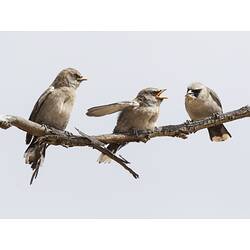General Description
Swallow-like bird. Grey, palest on belly, with a small black facial mask that does not extend behind the eye. Tail black with a white patch at end. In flight, underwings whitish. Juveniles are less uniform grey on belly, streaked with brown on upper parts. To 18 cm.
Biology
Resident throughout most of its range, but in the northern Top End and other places is a regular seasonal visitor. Occurs alone, in pairs or flocks. Often seen soaring and swooping. It eats mostly invertebrates, capturing them on the wing or flying out to take them from a perch. At night roosts in a tree, sometimes in a communal cluster. Across its range it breeds Jul-May; in northern WA and Top End it breeds Jul-Dec and Feb-May. Nests in single pairs or sometimes in colonies with other woodswallows. Other adults may assist with nest building, incubating and feeding the young. Nests are built in a fork or other position in a tree or shrub, or on power poles and other structures. Each nest is a shallow cup of sticks, grass or other plant matter. Eggs vary widely in colour, usually a variation of whitish with darker markings. Clutch size is 1-5.
Distribution
Across Australia.
Habitat
Prefers dry open forest and grassland.
More Information
-
Animal Type
-
Animal SubType
-
Brief Id
Grey woodswallow with a small black facial mask that does not extend behind the eye.
-
Colours
Grey, Black
-
Maximum Size
18 cm
-
Habitats
-
Diet
Invertebrates
-
Diet Categories
Invertebrates
-
Endemicity
-
Commercial
No
-
Conservation Statuses
CITES: Not listed, FFG Threatened List: Not listed, EPBC Act 1999: Not listed, IUCN Red List: Least Concern
-
Taxon Name
-
Common Name
Black-faced Woodswallow
-
Kingdom
-
Phylum
-
Subphylum
-
Class
-
Order
-
Family
-
Genus
-
Species Name
cinereus



